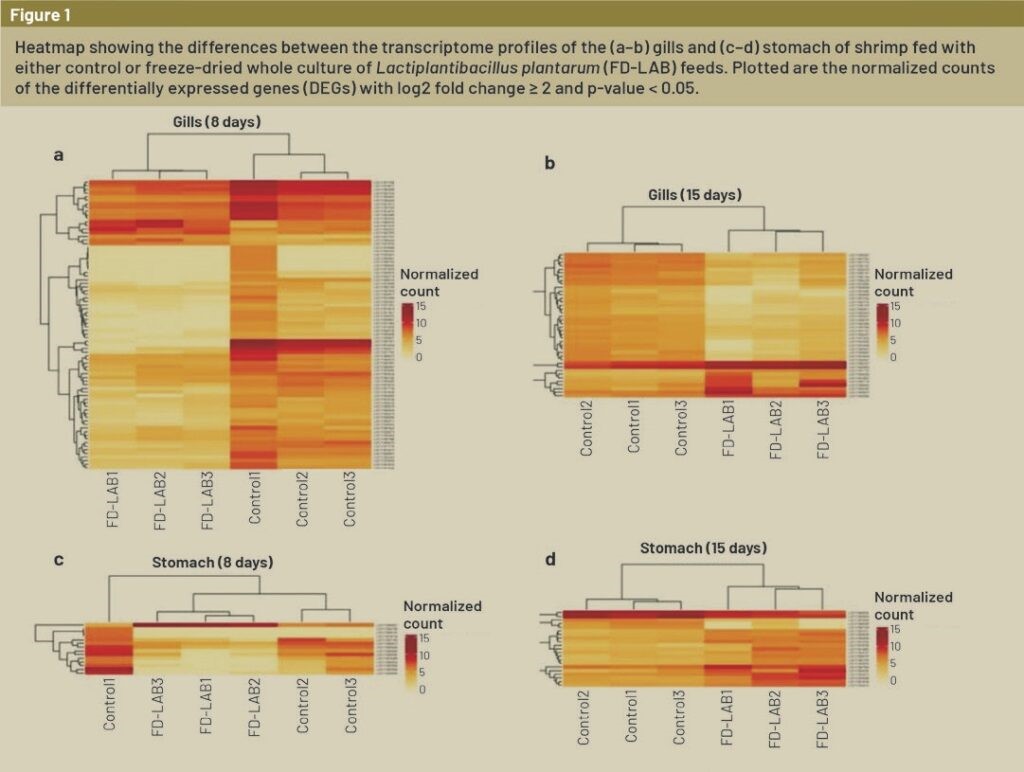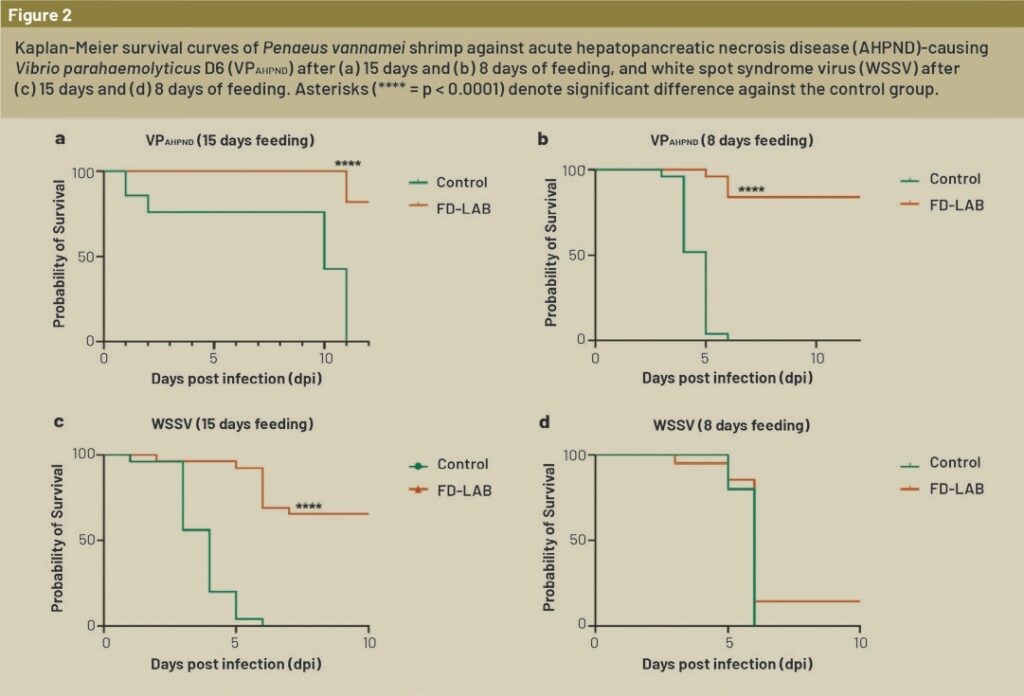Shrimp aquaculture faces significant challenges from bacterial and viral diseases like acute hepatopancreatic necrosis disease (AHPND) and white spot syndrome virus (WSSV). Recent research highlights the potential of Lactiplantibacillus plantarum (FD-LAB) as a dietary immunostimulant to enhance shrimp immunity. Transcriptome analysis revealed that FD-LAB supplementation modulates immune-related genes and circular RNAs (circRNAs), boosting immune memory and pathogen resistance.
Shrimp aquaculture plays a crucial role in global food security but faces significant challenges, particularly from diseases that cause severe economic losses, especially in Asia. Major diseases include bacterial infections like acute hepatopancreatic necrosis disease (AHPND) and viral threats such as white spot syndrome virus (WSSV). Due to their lack of adaptive immunity, shrimp rely on innate immune responses to combat pathogens.
To enhance shrimp immunity, research focuses on immunostimulants, which improve disease resistance. These include synthetic compounds and naturally derived substances from plants, fungi, and bacteria.
Lactic acid bacteria (LAB), such as Lactiplantibacillus plantarum, are widely used in shrimp aquaculture as dietary immunostimulants. Studies have shown that LAB supplementation improves growth, gut microbiome composition, and immune responses in Penaeus vannamei, increasing survival rates against infections.
Advancements in transcriptome analysis have deepened our understanding of shrimp immunity, including immune responses to AHPND and WSSV. Additionally, noncoding RNAs, such as circular RNAs (circRNAs), regulate immune gene expression. However, the effects of immunostimulation on circRNA expression remain unexplored.
A recent concept in crustacean immunity, “trained immunity”, suggests that exposure to immunostimulants like freezeried L. plantarum (FD-LAB) may enhance immune memory in Penaeus vannamei, improving resistance to secondary infections. This study investigates the potential of FD-LAB in priming shrimp immunity.
Materials and Methods
» Shrimp and Feed Preparation: Juvenile P. vannamei (0.87 ± 0.24 g) were divided into control and FD-LAB groups and acclimatized for seven days. Feed was supplemented with freeze-dried L. plantarum (FD-LAB) at 34.2 mg/g. Shrimp were reared in recirculating tanks with monitors water conditions and fed thrice daily for either 8 or 15 days.
» RNA Extraction and Sequencing: Total RNA from shrimp gill and stomach tissues was extracted, and quality was assessed. Library preparation was done using the Illumina Stranded mRNA Prep kit, followed by sequencing on an Illumina MiSeq platform.
» Transcriptome and circRNA Analysis: Quality control and differential expression analysis were performed using bioinformatics tools such as STAR, RSEM, and DESeq2. circRNA detection was conducted using the CIRIquant pipeline.
» qPCR Validation: Differentially expressed genes (DEGs) and circRNAs were validated via qPCR. RNA was reverse transcribed, and amplification was performed using specific primers.
» Bacterial and Viral Challenge Tests: Shrimp were challenged with Vibrio parahaemolyticus (AHPND) or WSSV via immersion. Survival rates were analyzed using the Kaplan-Meier method, including additional tests for trained immunity.
Results
RNA sequencing quality & overview
RNA sequencing was performed on shrimp gill and stomach samples after 8 and 15 days of feeding with FDLAB or control feed. The sequencing generated ~180 million high-quality reads (Q>30), supporting reliable downstream analyses.
Transcriptome profile & gene expression changes
FD-LAB supplementation led to differential gene expression (DEG):
» Gills: 80 DEGs (8 days), 40 DEGs (15 days) (Figure 1).

» Stomach: 14 DEGs (8 days), 22 DEGs (15 days).
» 17 genes were upregulated, 103 downregulated.
» DEGs included immune-related genes involved in pathogen recognition, antimicrobial response, and immune memory.
» Other enriched pathways: transcription, translation, ecdysis, and metabolic processes.
qPCR validation of DEGs
qPCR confirmed RNA-seq findings, validating immune-related gene expression changes:
» Gills: Upregulation of antilipopolysaccharide factor-like (ALF) (8 days), ficolin-1-like (FCN1) (15 days); downregulation of mucin 5ac-like (Muc5ac) (8 days).
» Stomach: thiopurine S-methyltransferase-like (TPMT) and leukocyte elastase inhibitor B-like (SERPINB1) upregulated (15 days).
» Additional immune genes (prophenoloxidase [proPO], superoxide dismutase [SOD], lysozyme [LYZ]) were upregulated, particularly LYZ in gills (15 days).
Differential expression of circRNAs
» Gills: 248 DECs
» Stomach: 226 DECs
» Parental RNAs of DECs were linked to immune memory, stress response, and toxin binding.
» Gene ontology (GO) analysis indicated roles in molecular functions (heme/ion binding), peptide crosslinking, and cell remodeling.
Validation of differentially-expressed circular RNAs (DECs) via qPCR
» Validated DECs: Down syndrome cell adhesion molecule-like protein (DSCAM), heat shock 70 kDa protein cognate 4-like (HSP70), aminopeptidase N-like (APN), and extensin-like (ETX).
» Gene expression patterns of parental RNAs were largely consistent with circRNAs, confirming modulation upon FD-LAB supplementation.
Trained immunity & pathogen resistance
V. parahaemolyticus (VPAHPND) and WSSV challenge tests:
» 15-day FD-LAB feeding significantly increased shrimp survival rates against both pathogens.
» 8-day feeding improved survival against VPAHPND but not WSSV.
» Post-FD-LAB feeding (7-14 days): Enhanced survival, indicating potential trained immunity mechanisms. (Figure 2).

Discussion
FD-LAB enhances immunity and immune memory in shrimp
Dietary supplementation with L. plantarum (FD-LAB) induced significant transcriptomic changes in P. vannamei, particularly in genes related to immunity and immune memory. The whole culture of FD-LAB retains bioactive compounds, enhancing its probiotic potential. Transcriptome analysis revealed the differential expression of Mucin-5ac (Muc5ac), a key component of the mucus barrier, which was downregulated in gills, potentially influencing pathogen resistance.
Regulatory immune proteins such as SERPINB1 were upregulated, suggesting their role in immune modulation and bacterial inhibition. The antibacterial gene anti-lipopolysaccharide factor (ALF) was also upregulated in both gills and stomach, contributing to bacterial and viral resistance.
Genes related to immune memory, including Thiopurine Methyltransferase (TPMT) and Histone H1-delta (HisH1), were differentially expressed. TPMT influences DNA methyl, a key mechanism in trained immunity, while HisH1regulates immune gene expression and has antimicrobial properties. The upregulation of Ficolin-1 (FCN1), involved in pathogen recognition and phagocytosis, suggest an improved immune response. These changes in pathogen recognition receptors (PRRs) indicate immune priming, a hallmark of trained immunity.
Circular RNAs as immune regulators
FD-LAB supplementation also modulated the expression of circRNAs, which play crucial roles in immune regulation. Notable examples include DSCAM, HSP70, EXT, and APN. DSCAM is involved in immune memory and pathogen-specific immunity, while HSP70 function as a damage-associated molecular pattern (DAMP) that activates innate immune responses. EXT and APN were differentially expressed, possibly contributing to antimicrobial responses and resistance to AHPND.
Circular RNAs targeting cuticle protein genes were downregulate, which may have helped inhibit WSSV infection, while those related to Rab genes were upregulated, consistent with previous reports on WSSV resistance in shrimp. These findings suggest that circRNAs influence the regulation of immune-related genes and contribute to trained immunity.
Trained immunity and pathogen resistance
Challenge tests demonstrate the FD-LAB supplementation enhanced shrimp resistance to V. parahaemolyticus (VPAHPND) and WSSV. A 15-day feeding period significantly increased survival against both pathogens, while an 8-day period provided protection against VPAHPND but not WSSV. Seven days after FD-LAB intake, shrimp still exhibited increased survival rates against both pathogens, suggesting trained immunity. However, after 14 days, protection remained against WSSV but not VPAHPND, indicating stimulus-specific immune memory.
Conclusion
FD-LAB supplementation enhances shrimp immunity through the differential expression of immune-related genes and circRNAs. The induced immune priming improves pathogen recognition, antimicrobial responses, and epigenetic regulation, making FD-LAB a promising functional feed additive for disease prevention in shrimp aquaculture.
By John Paul Matthew Domingo Guzman, Reiko Nozaki, Mikio Aoki, Hiroshi Kuwahara, Kazuki Mikata, Keiichiro Koiwai , Hidehiro Kondo, Ikuo Hirono
See more:
- Effects of micro-algae commonly used in aquaculture on acyl-homoserine lactone quorum sensing
- Is the shrimp hatchery the most important part of a successful crop?
- Genetic parameters and comparison of stress-tolerance traits in different strains of Pacific white shrimp
DOMESTICATED SHRIMP POSTLARVAE – THE KEY TO SUCCESS

 Tiếng Việt
Tiếng Việt 中文 (中国)
中文 (中国)